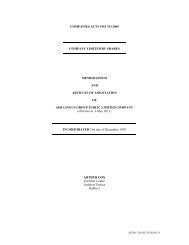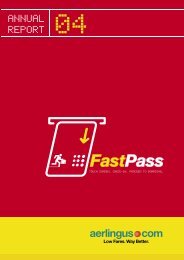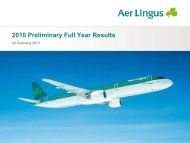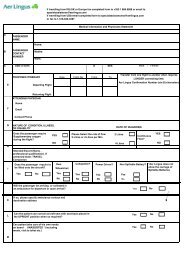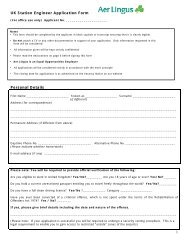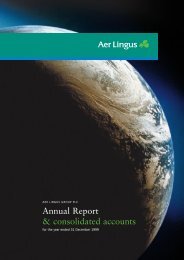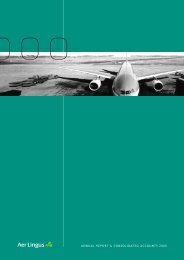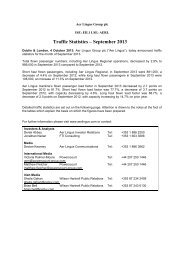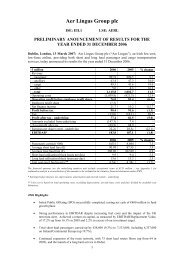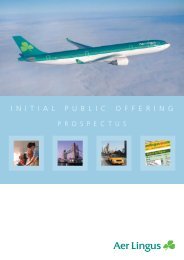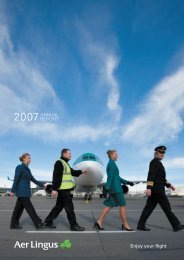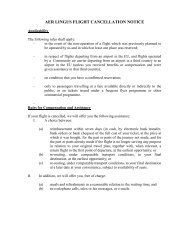annual report 2009 - Aer Lingus
annual report 2009 - Aer Lingus
annual report 2009 - Aer Lingus
You also want an ePaper? Increase the reach of your titles
YUMPU automatically turns print PDFs into web optimized ePapers that Google loves.
64 Financial Statements <strong>Aer</strong> <strong>Lingus</strong> Group Plc – Annual Report <strong>2009</strong>Notes to the Consolidated Financial Statements [continued]3 Financial risk management3.1 Financial risk factorsThe Group’s activities expose it to a variety of financial risks: market risk (including currency risk, cash flow interest rate risk and pricerisk), credit risk, liquidity risk and commodity price risk. The Group’s overall risk management programme focuses on the unpredictabilityof financial markets and seeks to minimise potential adverse effects on the Group’s financial performance. The Group uses derivativefinancial instruments to hedge certain risk exposures.Risk management is carried out by a central treasury department (group treasury) under policies approved by the board of directors.Group treasury identifies, evaluates and hedges financial risks in close co-operation with the Group’s operating units. The Board provideswritten principles for overall risk management, as well as written policies covering specific areas, such as foreign exchange risk, interestrate risk, credit risk, use of derivative financial instruments and non-derivative financial instruments, and investment of excess liquidity.(a) Market risk(i) Foreign exchange riskThe main currency exposures result from a deficit in US dollars and a surplus in sterling. A large proportion of the group treasuryfunction’s work in relation to foreign exchange rate risk relates to the management of the Group’s cashflow exposures. Significantcurrency exposures are managed for the current and next financial years on a selective hedging basis. The dollar deficit arises becausethe dollar costs for fuel and aircraft rentals, etc., exceed dollar sales in the US. The sterling surplus arises because UK sales exceedsterling costs. Profits are reduced by a stronger dollar and/or a weaker sterling.Additionally, significant currency exposure results from the US dollar capital commitments relating to the purchase of aircraft.Acquisition costs are increased by a stronger dollar.The group treasury function manages the following currency risk generating activities: cashflow exposures, non-cashflow incomestatement exposures and balance sheet exposures. The products used by the group treasury function in managing currency risk arepredominantly forward foreign exchange contracts.Currency risks are hedged on a selective hedging basis. The Group’s risk management policy targets a minimum of 50% cover for theseexposures for the current financial year and a minimum of 25% cover for the following financial year. In addition, a minimum of 50%of the committed flight equipment capital expenditure will be hedged when the commercial contract is signed. This minimum levelis actively reviewed in the context of the scale and delivery timescales for flight equipment.Based on the surplus in sterling for the year ended 31 December <strong>2009</strong>, a 5% weakening of the EUR/GBP exchange rate over theyear end rate would result in a reduction in profit of €4.0m for the year. Based on the deficit in US dollars for the year ended31 December <strong>2009</strong>, a 5% strengthening of the EUR/USD exchange rate over the year-end rate would result in a reduction in profitof €15.4m for the year.(ii) Interest rate riskThe Group is exposed to interest rate risk associated with its long-term funding requirements and its programme of surplus fundsinvestment. Higher interest rates increase the costs of gross debt and lower interest rates lower the returns from cash investments.Overall the Group is in a net cash position. Interest rate exposures on debt are managed by fixing interest rates or by placing matchinginvestments, which serve as natural hedges in relation to both interest rate and currency exposures on the debt. In addition to theseinvestments, the Group holds surplus cash, predominantly in euro, and therefore the major interest rate exposure the Group has is tomovements in the euro interest rate. This exposure is actively reviewed and managed.A 1% fall in interest rates based on net surplus cash throughout <strong>2009</strong> would reduce profits by €4.9m.



